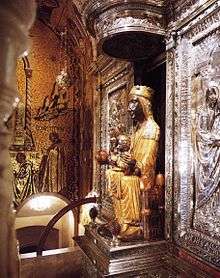Virgin of Montserrat
| Virgin of Montserrat | |
|---|---|
 | |
| Our Lady of Montserrat, Patroness of Catalonia | |
| Venerated in | Roman Catholic Church |
| Major shrine | Santa Maria de Montserrat Abbey, Catalonia, Spain |
| Attributes | Blessed Virgin Mary, golden robes, crown, Infant Jesus, orb |
| Patronage | Catalonia |
Our Lady of Montserrat or the Virgin of Montserrat (Catalan: Mare de Déu de Montserrat) is a statue of the Virgin Mary and infant Christ venerated at the Santa Maria de Montserrat monastery on the Montserrat Mountain in Catalonia. She is the Patron Saint of Catalonia,[1][2] an honour she shares with Saint George (Sant Jordi in Catalan).[3][4] It is one of the black Madonnas of Europe, hence its familiar Catalan name, la Moreneta ("the little dark-skinned one" or "the little dark one"). Believed by some to have been carved in Jerusalem in the early days of the Church, it is more likely a Romanesque sculpture in wood from the late 12th century.[5]
History
The mountain of Montserrat has been of religious significance since pre-Christian times, when the Romans built a temple to honor Venus.[6]
By one account, the image of the Madonna was moved to Montserrat in 718, to avoid the danger posed by invading Saracens.[7]
Legend has it that the Benedictine monks could not move the statue to construct their monastery, choosing to instead build around it. The statue's sanctuary is located at the rear of the chapel, where an altar of gold surrounds the icon, and is now a site of pilgrimage.
Description
The 95-cm (38-inch) statue shows evidence of Byzantine conventional and stylized form, and is painted in polychrome. The reliquary statue of Sainte-Foy in Conques (southern France) may have been a model. The art historical designation for this type of pose is called "Throne of Wisdom". The body is thin, the face elongated. She holds an orb of the earth in her right hand. The Child's hand is raised in a formalized and traditional Eastern blessing.[8]
In 2001 renovators working for the government observed that the black hands and face of La Moreneta had over the centuries undergone a change in colour. They attribute the change—from a lighter tone to black—either to prolonged exposure to candle smoke or a chemical reaction caused by a varnish used as a paint sealant. The statue was repainted black by successive generations of restorers. A series of tests, including X-rays, revealed the statue's original colour and also showed that the last repainting took place at the turn of the 18th century.[9]
Veneration
After making a pilgrimage to Our Lady of Montserrat around 1203, Peter Nolasco went to Barcelona where he began to practice various works of charity. Nolasco became concerned with the plight of Christians captured in Moorish raids and that he decided to establish a religious order to succor these unfortunates.
Upon his recovery from battle wounds, Ignatius of Loyola visited the Benedictine monastery of Montserrat (on 25 March 1522), where he laid down his military accouterments before the image.[7] He then led a period of asceticism before later founding the Society of Jesus.
The hymn to the Virgin of Montserrat, known as "el Virolai" and sung at noon each day by the Escolania de Montserrat boys' choir, begins with the words: "Rosa d’abril, Morena de la serra..." (April rose, dark-skinned lady of the mountain...). Therefore, this virgin is sometimes also known as the "Rosa d'abril".[10] Her feast is kept on April 27.[11]
Patronage
The statue has always been considered one of the most celebrated images in Spain. "La Moreneta" is one of Catalonia's two patron saints, together with Sant Jordi (Saint George).[9]
Given Name
The name Montserrat, traditionally abbreviated to Serrat, Rat, Rateta, Tat or Tóna, and also to Montse in recent years, is a popular girl's name in Catalonia.[12][13][14][15][16][17][18]
See also
- Llibre Vermell de Montserrat
- Roman Catholic Marian art
- Montserrat (given name)
- Montserrat (disambiguation)
References
- ↑ "Our Lady", on the official "Visit Montserrat Monastery" website (in Catalan, Spanish, English, French and Russian). She was declared the Patron Saint of Catalonia by Pope Leo XIII in 1881.
- ↑ "The Feast", under "Spirituality", on the official Montserrat Monastery website (in Catalan, Spanish and English).
- ↑ "Tradition in Catalonia", in the Sant Jordi 2014 section of the Catalan Government's website (in Catalan, Spanish and English).
- ↑ "Els Patrons de Catalunya", Archdiocese of Barcelona (text in Catalan).
- ↑ Simonis, Damien. Spain, Lonely Planet, 2009 (page 367) ISBN 174179000X
- ↑ "Montserrat monastery", Barcelona
- 1 2 Duricy, Michael P., "Black Madonnas: Our Lady of Montserrat", Marian Library, University of Dayton
- ↑ Roccosalvo C.S.J., Joan L., "Elegance Personified: The Black Madonna of Montserrat", Sacred Architecture Journal, Vol. 21, spring 2012
- 1 2 Wilkinson, Isambard. "Montserrat Black Virgin 'was white originally'", The Telegraph, 13 April 2001
- ↑ Escolania de Montserrat – El Virolai
- ↑ https://www.catholicculture.org/culture/liturgicalyear/calendar/day.cfm?date=2016-04-27
- ↑ Ruaix, Josep. Català Complet 3. Curs superior de llengua, Editorial Claret, 1998, p. 23-26 (in Catalan)
- ↑ "De Rats i Tats", Núria Puyuelo, El Punt / Avui, 2 May 2014 (in Catalan) [consulted 7 April 2015]
- ↑ "Montserrat", Sílvia Soler, Ara, 29 June 2013 (in Catalan) [consulted 7 April 2015]
- ↑ "Catalanot II. Noves tendències en la tradició catalana d'escurçar els noms de font", Melancholia, 21 November 2010 (in Catalan) [consulted 7 April 2015]
- ↑ "De Rats i Tats", Núria Puyuelo, El Punt / Avui, 2 May 2014 (in Catalan) [consulted 7 April 2015]
- ↑ "Montserrat", Sílvia Soler, Ara, 29 June 2013 (in Catalan) [consulted 7 April 2015]
- ↑ "Catalanot II. Noves tendències en la tradició catalana d'escurçar els noms de font", Melancholia, 21 November 2010 (in Catalan) [consulted 7 April 2015]
| Wikimedia Commons has media related to Virgin of Montserrat. |